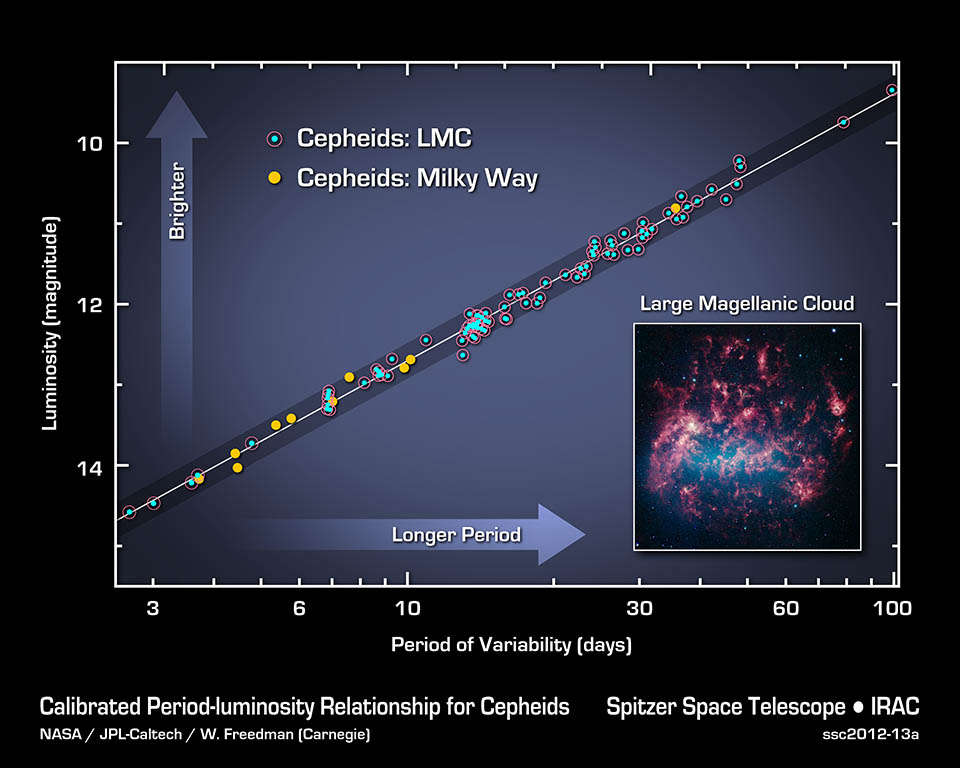NASA | JPL-Caltech | Spitzer | 2012 Oct 03
The Hubble constant is named after the astronomer Edwin P. Hubble, who astonished the world in the 1920s by confirming our universe has been expanding since it exploded into being 13.7 billion years ago. In the late 1990s, astronomers discovered the expansion is accelerating, or speeding up over time. Determining the expansion rate is critical for understanding the age and size of the universe.
Unlike NASA's Hubble Space Telescope, which views the cosmos in visible light, Spitzer took advantage of long-wavelength infrared light to make its new measurement. It improves by a factor of 3 on a similar, seminal study from the Hubble telescope and brings the uncertainty down to 3 percent, a giant leap in accuracy for cosmological measurements. The newly refined value for the Hubble constant is 74.3 plus or minus 2.1 kilometers per second per megaparsec. A megaparsec is roughly 3 million light-years.
"Spitzer is yet again doing science beyond what it was designed to do," said project scientist Michael Werner at NASA's Jet Propulsion Laboratory in Pasadena, Calif. Werner has worked on the mission since its early concept phase more than 30 years ago. "First, Spitzer surprised us with its pioneering ability to study exoplanet atmospheres," said Werner, "and now, in the mission's later years, it has become a valuable cosmology tool."
In addition, the findings were combined with published data from NASA's Wilkinson Microwave Anisotropy Probe to obtain an independent measurement of dark energy, one of the greatest mysteries of our cosmos. Dark energy is thought to be winning a battle against gravity, pulling the fabric of the universe apart. Research based on this acceleration garnered researchers the 2011 Nobel Prize in physics.
"This is a huge puzzle," said the lead author of the new study, Wendy Freedman of the Observatories of the Carnegie Institution for Science in Pasadena. "It's exciting that we were able to use Spitzer to tackle fundamental problems in cosmology: the precise rate at which the universe is expanding at the current time, as well as measuring the amount of dark energy in the universe from another angle." Freedman led the groundbreaking Hubble Space Telescope study that earlier had measured the Hubble constant.
Glenn Wahlgren, Spitzer program scientist at NASA Headquarters in Washington, said infrared vision, which sees through dust to provide better views of variable stars called cepheids, enabled Spitzer to improve on past measurements of the Hubble constant.
"These pulsating stars are vital rungs in what astronomers call the cosmic distance ladder: a set of objects with known distances that, when combined with the speeds at which the objects are moving away from us, reveal the expansion rate of the universe," said Wahlgren.
Cepheids are crucial to the calculations because their distances from Earth can be measured readily. In 1908, Henrietta Leavitt discovered these stars pulse at a rate directly related to their intrinsic brightness.
To visualize why this is important, imagine someone walking away from you while carrying a candle. The farther the candle traveled, the more it would dim. Its apparent brightness would reveal the distance. The same principle applies to cepheids, standard candles in our cosmos. By measuring how bright they appear on the sky, and comparing this to their known brightness as if they were close up, astronomers can calculate their distance from Earth.
Spitzer observed 10 cepheids in our own Milky Way galaxy and 80 in a nearby neighboring galaxy called the Large Magellanic Cloud. Without the cosmic dust blocking their view, the Spitzer research team was able to obtain more precise measurements of the stars' apparent brightness, and thus their distances. These data opened the way for a new and improved estimate of our universe's expansion rate.
"Just over a decade ago, using the words 'precision' and 'cosmology' in the same sentence was not possible, and the size and age of the universe was not known to better than a factor of two," said Freedman. "Now we are talking about accuracies of a few percent. It is quite extraordinary."
Expansion of Space Measurement Improved
Carnegie Institution for Science | 2012 Oct 03
Carnegie Hubble Program: A Mid-infrared Calibration of the Hubble Constant - Wendy L. Freedman et al
- Astrophysical Journal 758(1) 24 (2012 Oct 10) DOI: 10.1088/0004-637X/758/1/24
arXiv.org > astro-ph > arXiv:1208.3281 > 16 Aug 2012
Spitzer Provides Most Precise Measurement Yet of the Universe’s Expansion
Universe Today | Nancy Atkinson | 2012 Oct 03

